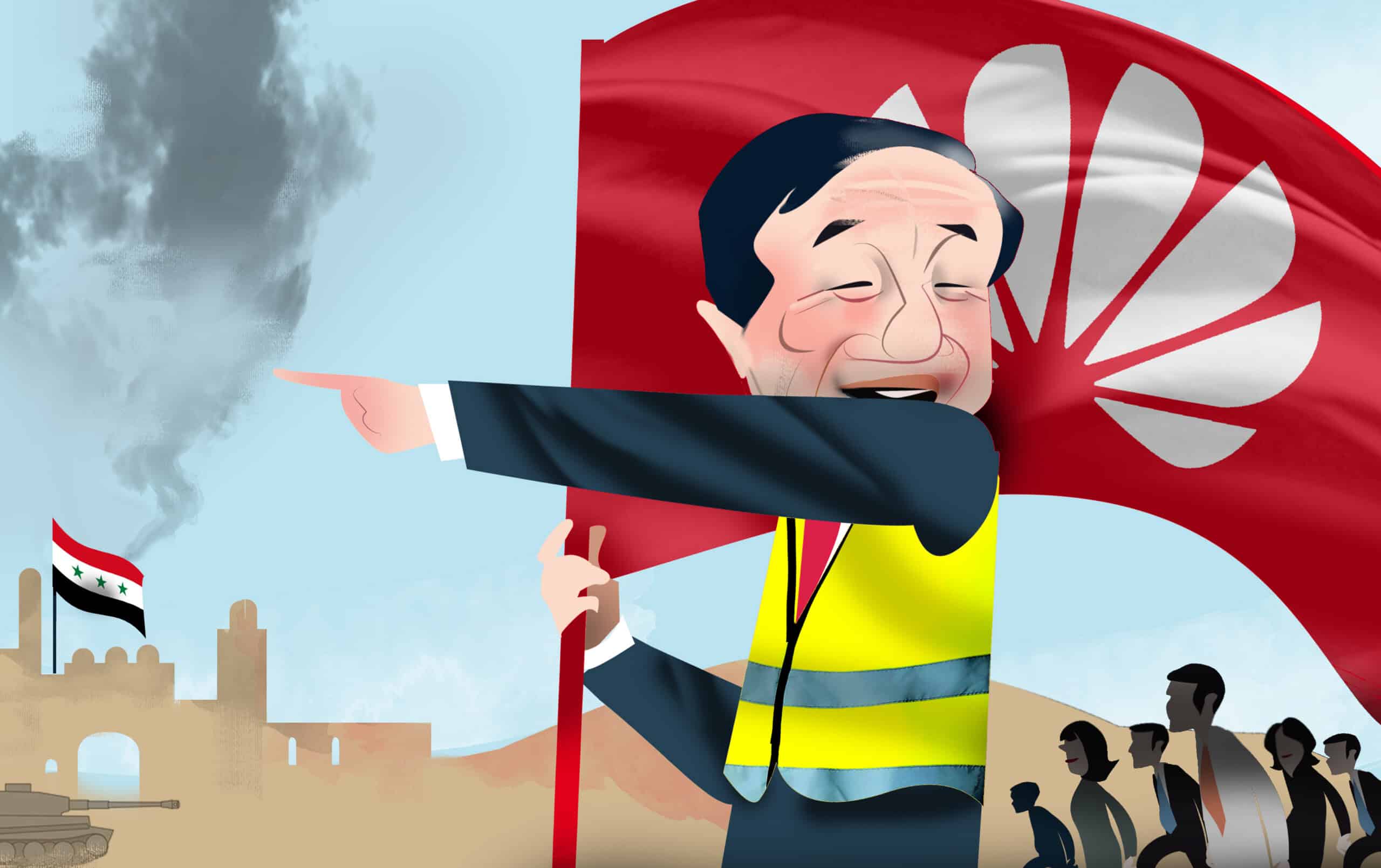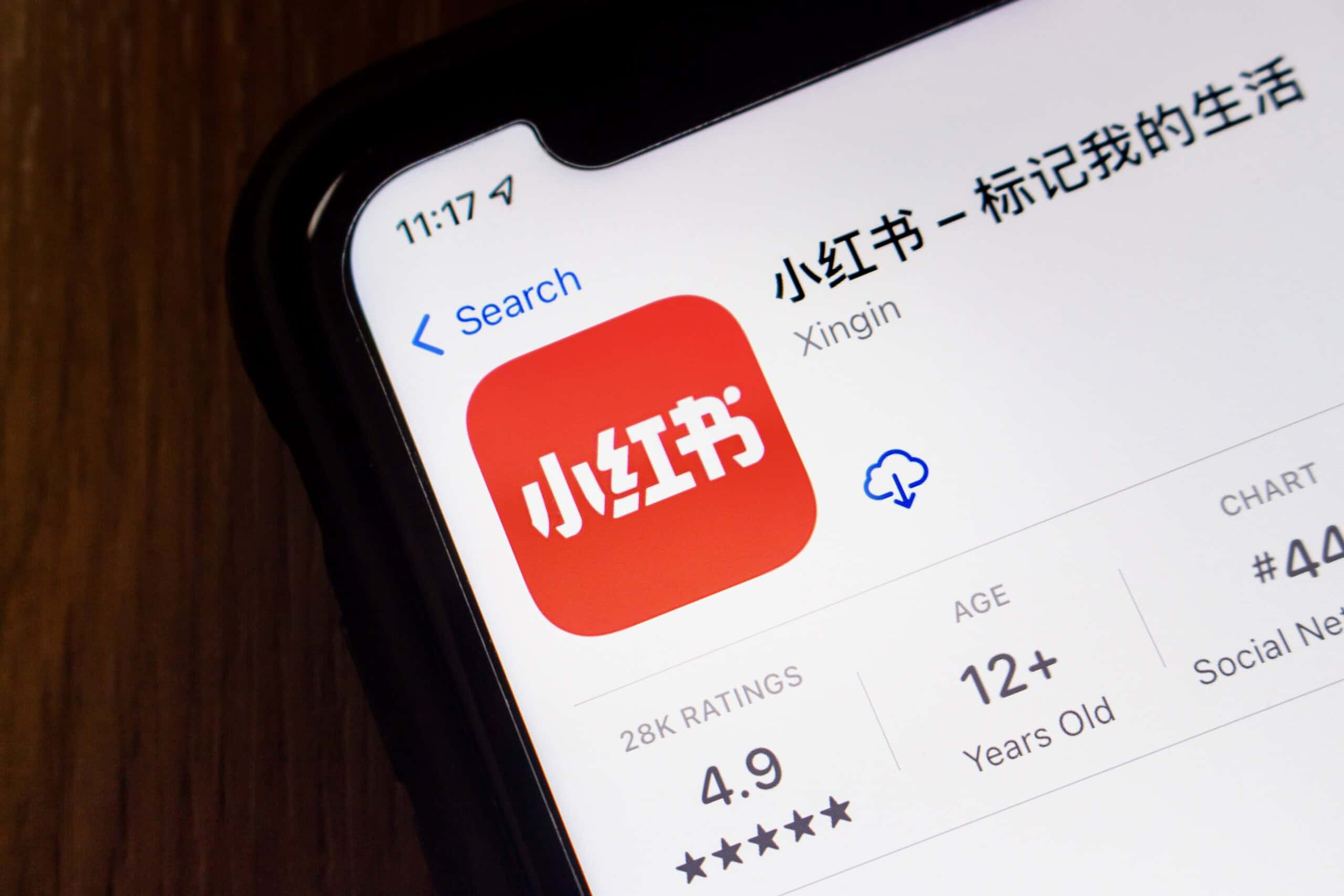
It was New Year’s Eve, and Vijay Shekhar Sharma was out of breath. Standing on a stage in front of his employees, the chief executive of digital payment startup Paytm was screaming into a microphone and jumping up and down as red and yellow lights flashed around him.
“We ripped 2016,” Sharma said, almost falling over as the audience whooped and hollered. “2017 will be ours. How won’t it?!”
Just seven weeks earlier, India’s Prime Minister, Narendra Modi, had announced he was invalidating more than 80 percent of India’s currency notes in an effort to curb illegal activity. In a country where cash reigned, Paytm had been plugging digital payments for years with decent progress. But now, as Sharma and his audience knew, demonetization would change everything.

Credit: Biswarup Ganguly, Creative Commons
“Not only the country, but the whole world is looking to us,” Sharma said, as an emcee with bleached hair and a gold chain bounced around him.
Sharma had reason to be confident. Paytm’s engineers had trained in China for more than a year and reproduced the technology platform of Ant Financial, the Chinese company considered the world’s largest in digital payments. And more importantly, Ant and its parent company, the Alibaba Group, had invested $1 billion the previous year to become the largest shareholders in Paytm. Alibaba was betting that Paytm could replicate its success at ecommerce, digital payments and financial services in the only market that could grow to match China.
And the bet seemed poised to pay off. Indians had created 160 million Paytm accounts by the end of 2016, making the company’s user base more than three times the size of its nearest rival. Paytm, Sharma bragged, would become India’s first $100 billion company.
And why not? For more than a decade, America’s leading venture capital firms have plowed capital into India’s versions of Silicon Valley, in search of dynamic entrepreneurs and hot ideas. Now, India’s hottest startups are also being courted by deep-pocketed Chinese investment firms, eager to invest overseas and leverage China’s dominance as a maker of smartphones and popular apps like TikTok, the video-sharing platform. With the U.S. increasingly closed off to Chinese investments over national security concerns, India had become the go-to market.
A decade ago, Chinese investment in India was negligible. But today, 18 of India’s 30 most valuable “unicorns” — or startups worth at least $1 billion — are backed by Chinese investment firms, according to a study by Gateway House, a Mumbai-based think tank. And a growing number of “Soonicorns” — those on the verge of gaining unicorn status are also funded by Chinese firms.
“In 2014, Chinese VCs started entering the Indian market because India’s smartphone penetration reached 20 percent — the same level at which the Chinese market took off,” says Santosh Pai, a partner at Link Legal India Law Services, which works on facilitating cross-border investment between India and China. “So that’s when they spotted all these startups like Swiggy [a food delivery app], Zomato [a restaurant aggregator] and Paytm.”
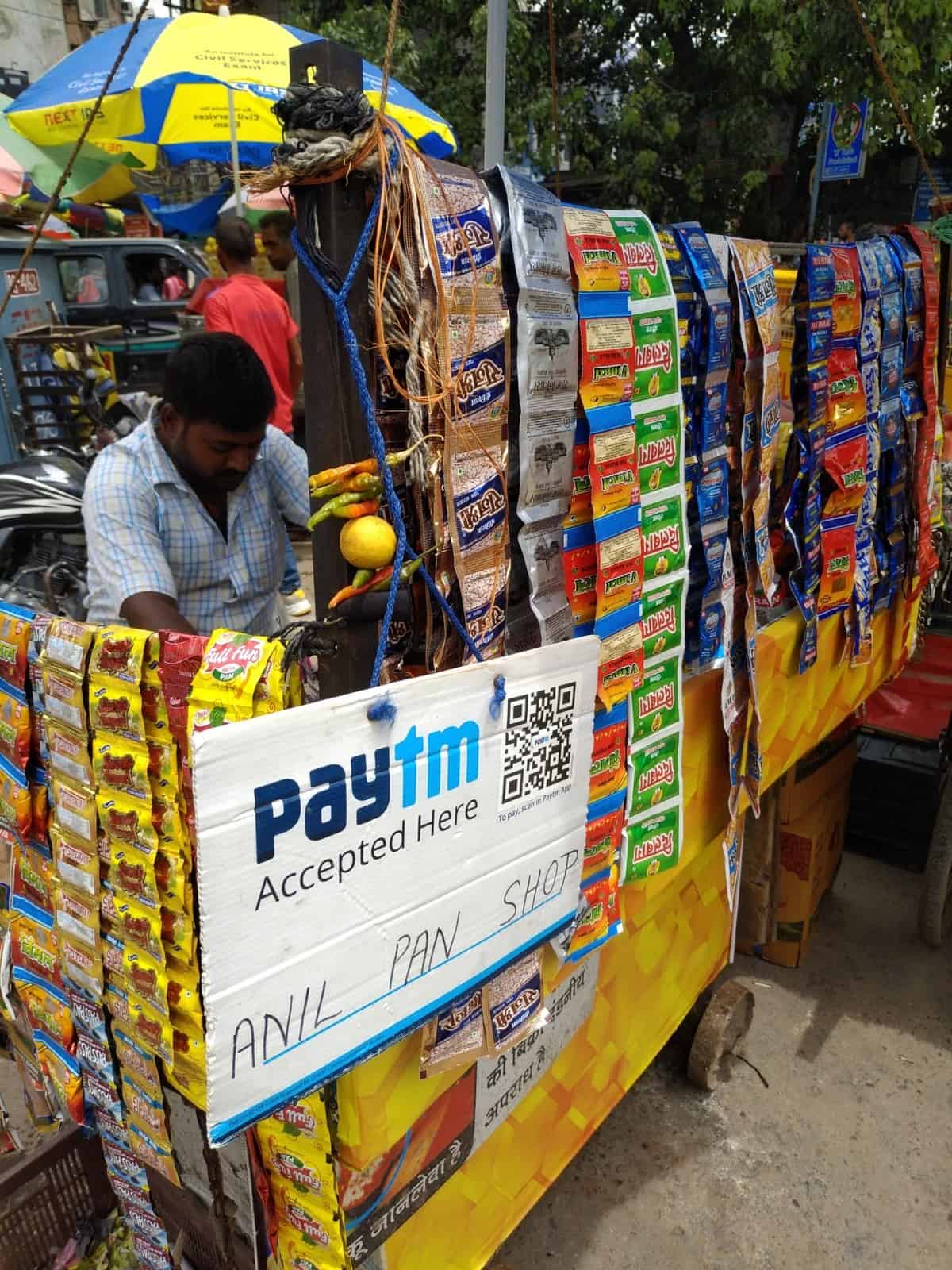
The early winners have been dynamic entrepreneurs like Sharma. His company, Paytm, has backing from Alibaba, Goldman Sachs, Softbank of Japan, SAIF Partners and Berkshire Hathaway, Warren Buffet’s investment firm. Valued at $16 billion in its last fundraising round, Paytm is now India’s most valuable unicorn, and Sharma has leapt onto the Forbes rich list, with a fortune valued at $2.4 billion.
Under Sharma, Paytm, which was founded in 2007, has gone through 17 fundraising rounds and raised about $5.4 billion — the vast majority of that during the past five years, according to Pitchbook, which tracks venture capital investments.
Sharma’s fundraising prowess is legendary.
Of course, Sharma, 42, has had a tough run of it since his New Year’s Eve speech in the early hours of 2017. His startup has faced stiff competition, regulatory hurdles and a constantly shifting ecommerce landscape, not to mention the stigma of being a Chinese-backed firm at a time of rising geopolitical tensions.
A series of border clashes between Indian and Chinese troops culminated in the June 16 killing of 20 Indian soldiers in the Galwan Valley, in north India. The Indian government retaliated by banning 59 Chinese apps, including TikTok, which had more users in India than anywhere else in the world. Anti-Chinese sentiment quickly spread, with calls for Indians to boycott Chinese goods and a resurgence of the slogan “be Indian, buy Indian.”
While Paytm has an Indian CEO, Indian offices, and an Indian workforce, Alibaba and Ant Financial own about 40 percent of it and Japan’s Softbank owns another 20 percent. Sharma owns only about 15 percent — which has raised questions about what counts as an Indian company.
“Nationalism has been driving policymaking for several years now,” says Prasanto K. Roy, a public policy consultant and technology writer. Sharma, he noted, has countered by “going out of his way to establish his nationalist credentials, including being the most prominent outlier backing the Reserve Bank of India’s data localization plan for payments players.”
But it might not be enough. On June 29, Manickam Tagore, a member of Parliament from the opposition Congress party, tweeted a photograph of the shareholding pattern of One97, Paytm’s parent company. If Chinese apps were banned, he argued, Paytm should be too. (Paytm declined requests for an interview, and Alibaba did not respond.)
Rajiv Dogra, a former Indian diplomat, says India’s recent actions against China could be a huge opening for American businesses.
“Indians spoke on Chinese phones, watched shows on Chinese television sets and drank cold water from Chinese fridges,” Dogra tells The Wire. “Now that has changed. We are willing to spend an extra Rupee to buy something non-Chinese.”
All of this will be a test for Paytm — and Alibaba.
THE NEXT 800 MILLION CUSTOMERS
Sharma got the idea for Paytm on a trip to Beijing around 2012. He was standing in the checkout line of a department store as he watched customers zip through by showing their cellphones. Cashiers had handheld devices connected to their computers that scanned QR, or quick response, codes on customers’ phones, allowing the money customers had loaded into a digital wallet to get transferred.
Sharma decided he had to bring this to India — but in reverse. Retail in India mostly involved street vendors, handcarts, and mom and pop shops with little technology. He wanted the vendors to have unique QR codes and customers to use their smartphones to scan them, transferring money from their wallets.
At the time, Sharma had already owned and sold several businesses, including making content management systems for newspapers. The son of a biology teacher who believed he was a prodigy, Sharma had grown up in Harduaganj, a suburb of a small town in northern India, tinkering with computers at his father’s school. He graduated at the top of his class from high school at 15, and then studied engineering at the highly regarded Delhi Technological University.

Credit: Jasveer10, Creative Commons
Not long after, he started One97 Communications, an online platform that sold cricket scores, horoscopes and ringtones for rapidly proliferating cell phones. The company was growing and generating cash, but One97’s board was skeptical about Sharma’s mobile payments idea. At the time, there were only 30 million smartphones in India and data usage was low. Sharma, confident the market would grow, offered to forfeit one percent of his equity if his plan led to losses.
The digital wallet, which he named Paytm (Pay Through Mobile), arrived just in time. Smartphone usage was growing, and network infrastructure and affordable data plans were improving. According to a recent report by Ericsson, the telecom equipment maker, data traffic per smartphone in India is now among the highest in the world.
Impressed by Sharma’s bets and growth, his investors started introducing him to larger, international investors.
“At that time, the market was soft,” says Sudheer Kuppam, then managing director of Intel Ventures and one of One97’s earliest investors. “You didn’t have late-stage investors in India. You had to go abroad for that.”
An introduction was made to Alibaba executives, who were scouting in the Indian market.
“The reason the Chinese are better suited for this market is it’s a bit like the Chinese market,” says Pai, of Link Legal India Law Services. “We used to think whatever worked in the U.S. would work here, but that is true only for the top 100 or 200 million customers. It was Chinese investors who discovered the next 800 million or so customers.”
We used to think whatever worked in the U.S. would work here, but that is true only for the top 100 or 200 million customers. It was Chinese investors who discovered the next 800 million or so customers.
Santosh Pai, Link Legal India Law Services
In meetings with Alibaba, Sharma pitched Paytm as recreating a bank in a smartphone and its unique value of helping the rural mom-and-pop shops in India. When he finally clinched the deal in early 2015, he and Jack Ma bonded over their similar humble origins and struggles with English.
Alibaba’s investment came as China’s new technology giants were looking to expand in international markets.
WeChat, the app backed by China’s e-commerce giant Tencent, had recently launched and failed in India. Now it was Alibaba’s turn. After Alibaba’s IPO in 2014, Ma made two trips to India and was keen to have a presence here as a way to “globalize” his company’s operations. To avoid Tencent’s mistake, Ma told Sharma he wanted to support an Indian entrepreneur for Alibaba’s push into India.
After it invested, Alibaba quickly set about developing Paytm and Sharma in its own image. Like Ma, Sharma became active on Twitter and raised his profile in the press. It worked. Sharma quickly became a celebrity in India, and in 2017 he was named one of Time magazine’s 100 Most Influential People, alongside Amazon’s Jeff Bezos and Jean Liu, who runs the Chinese ride-sharing company Didi-Chuxing.
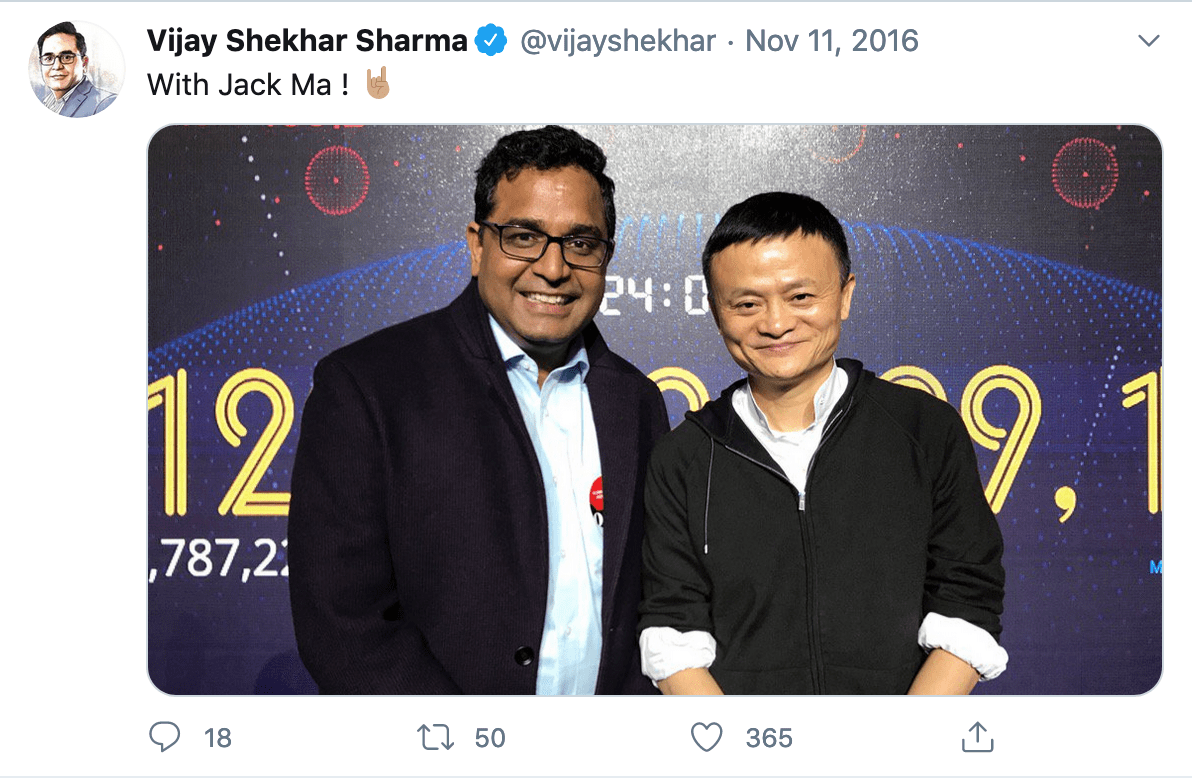
Credit: Vijay Shekhar Sharma on Twitter
“It’s as if Jack Ma is conducting an executive MBA for our [Paytm] executives,” Sharma later told reporters.
In addition to training Paytm engineers, Alibaba — and its Ant Financial unit — brought over systems they had used to help cut fraud, and a program to grow Paytm’s payments cloud, which allowed the company to grow from its origins in pay-as-you-go payments for mobile phones to owning all of customers’ recurring payments, from utility bills to school fees. It also began PayTM Mall to reverse engineer Alibaba’s model of payments built on ecommerce.
By the winter of 2016, Paytm — powered by Alibaba — was changing India’s financial landscape. With cash gone, Paytm turned from a noun to a verb, a means for money transfer. Sharma became India’s youngest self-made billionaire.
Which may be why he hardly noticed when the Indian government tried to get Paytm to adopt its own digital payments system, a platform called Unified Payments Interface (UPI). Whereas wallet digital payment apps like Paytm require an extra step in a transaction — first loading the digital wallet with funds — the UPI platform worked with banks to link directly to your checking account.
Sharma “didn’t want to use it,” says one expert on the UPI system who did not want to be named. “He didn’t like UPI.”
Sharma believed Paytm offered a better user experience than UPI, and besides, in December 2016, there were 88 million prepaid card or wallet transactions on Paytm and only two million UPI transactions. Within Paytm, UPI was seen as “sarkari,” a clunky, “governmental” system compared to the sleek platform Alibaba helped design.
But over the next year, as Alibaba encouraged Paytm to expand into an e-commerce site, with travel, movie and event ticket sales, and financial services offerings — even a service that lets users buy and trade gold. Newcomers Google Pay and Walmart-owned PhonePe were using the UPI infrastructure to launch payments businesses and improve user experience. Google Pay even came up with a virtual scratch card to give cash back to users, which helped it gain market share.
As more banks and companies came on board, the balance of digital payments started to shift, nudging Sharma to join. By February 2018, there were 113 million wallet payments while UPI payments had soared to 171 million. UPI payments continued to grow, forming nearly half of all digital payments through this April, according to data from India’s central bank. The share of wallet payments has continued to shrink.
As a late entrant to UPI, Paytm’s share of UPI payments have dropped to 13 percent, down from 27 percent a year ago.
“The perception of Paytm is wallet,” says Dewang Neralla, the chief executive of Atom Technologies, a digital payments company. The perception of UPI, by contrast, is Google.
Last November, when Paytm raised $1.66 billion to compete against Google and Walmart’s PhonePe, its losses had widened to a half a billion dollars, more than doubling from the previous year, according to analysts and figures released by Pitchbook.
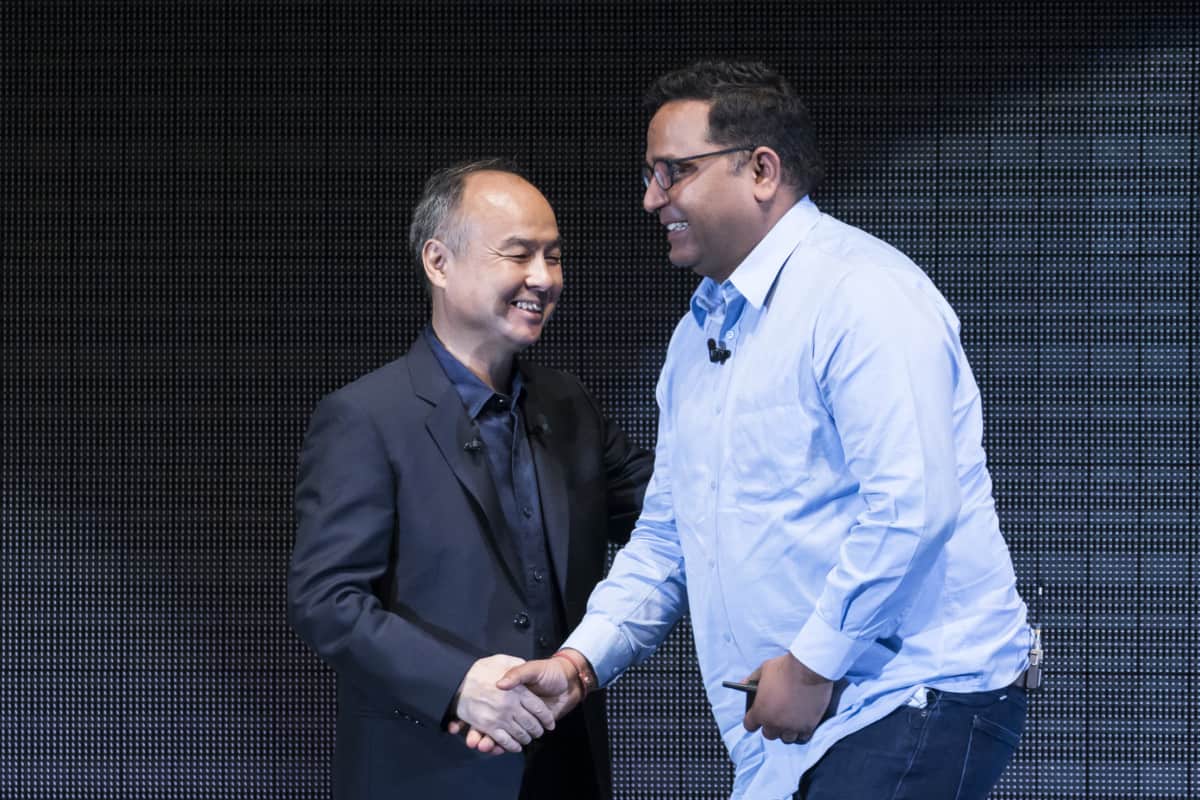
Credit: Tomohiro Ohsumi/Getty Images
Then Softbank, mired in turmoil after troubles linked to its investment in WeWork, reportedly asked Paytm to cut its losses and prepare for a public offering in the next five years. But that could be hard. Some traders now claim the company’s value has declined in the market for trading private shares, even though its backers include big names from the U.S. and China, including Berkshire Hathaway, SAIF Partners (the Asia focused firm originally established by Cisco), Silicon Valley Bank, T. Rowe Price and the Taiwanese chip designer MediaTek.
THREE’S A CROWD
In a video released this week, Sundar Pichai, chief executive of Alphabet, Google’s parent company, touted the company’s deep Indian roots.
Standing in front of an image of a softly lit field, Pichai was celebrating Google’s announcement of a $10 billion investment fund for India, some of it for digital payments, and noted Google Pay’s success digitizing small shops and grocery stores.
“I am sure my grandmother misses haggling over the price of vegetables in person,” he said, before commending Prime Minister Modi for getting so much of the country online.
Pichai, who was born in the southern city of Madurai, also had a virtual meeting with Modi this week. Google has even written to the U.S. Federal Reserve to propose recreating a UPI-like system in the United States.
“Building products for India first has helped us build better products for users everywhere,” he said.

Credit: Still from Google India video
In fact, today, the chief executives of Adobe, IBM, Microsoft and Google are all Indian-born. And some, like Pichai, are investing back home. Pichai’s recent announcement came as Google and other U.S. investors were preparing to invest billions of dollars in an Indian company called Jio Platforms. To further add to Paytm’s competition, Facebook’s WhatsApp, which has 400 million Indian users already, is preparing to enter the digital payments market.
“Paytm is in a tight spot,” says Ankur Bisen, a senior vice president at Technopak Advisors, a consulting firm. “They have spread themselves across too many fronts, leaving their core behind.”
And in its moment of highest need, Paytm could be cut off from Alibaba’s deep pockets.
In April, fearful that Chinese businesses would take over or acquire struggling Indian businesses during the Covid-19 pandemic, India’s government announced new regulatory screenings for investment proposals that come from neighboring countries — a move largely seen as targeting China. The initiative has effectively blocked Chinese money from entering the country.
“Not a single proposal has been cleared since this came on April 20, or has even been acknowledged,” says Shagoofa Rashid Khan, a partner at the law firm Cyril Amarchand Mangaldas. “This is going to impact deal making.”
While Chinese-backed companies like Paytm face an uphill battle at the moment, analysts say it would be a mistake to expect India to entirely turn its back on Chinese investment.
“India has a large, young, tech-savvy population that is tailor made for the kind of telecoms investment that China likes to make,” says Michael Kugelman, the deputy director and senior associate for South Asia at the Wilson Center, a Washington, D.C.-based think tank. India would be foolish to keep away Chinese investment, he adds. “When push comes to shove, India will go back to China.”
In the meantime, India stands to gain from the growing competition between U.S. and Chinese companies. Chinese firms have invested in 92 startups in recent years, according to this report in Gateway House, the Mumbai think tank, partly because India doesn’t have its own large-scale venture capital firms. That, analysts say, has allowed China to fill a void, and compete with U.S. firms for deals in India.
And compete they have. Before the ban, Chinese apps were among the most downloaded in India. And Chinese smartphones brands — led by Xiaomi and Oppo — dominate India, with a 72 percent market share, according to Gateway, far outselling Apple and Samsung. Alibaba has bet not just on Paytm, by far its biggest investment here, but at least half a dozen other Indian startups.
India is now considered one of the world’s most fiercely contested technology battlegrounds, but also one of the most complex.
“In a sector that lives and dies on regulation, it is not easy to make predictions,” Janmejaya Sinha, the chairman of the Boston Consulting Group’s India office, says of the competition in India. “Don’t think of this as a static situation.”

*Walmart holds a controlling stake in Flipkart as of 2018.
Data: Compiled by Gateway House.

Saumya Roy is a writer based in Mumbai. She has written for wsj.com, Forbes India, Mint newspaper and Outlook magazine, among others.

